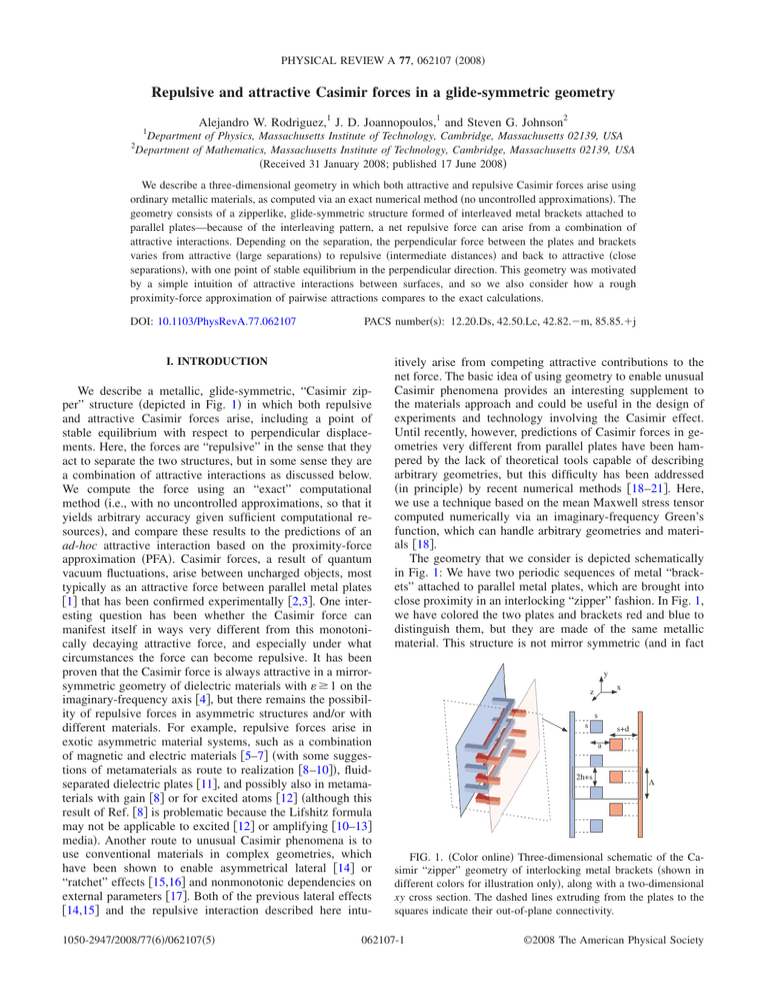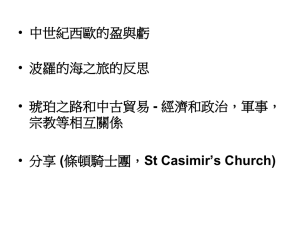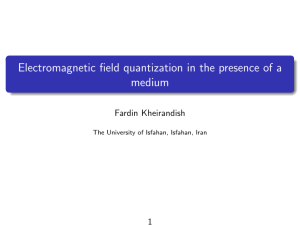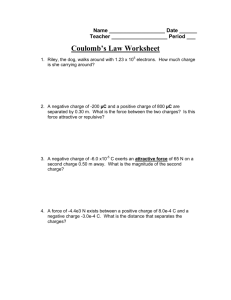Repulsive and attractive Casimir forces in a glide-symmetric geometry
advertisement

PHYSICAL REVIEW A 77, 062107 共2008兲 Repulsive and attractive Casimir forces in a glide-symmetric geometry 1 Alejandro W. Rodriguez,1 J. D. Joannopoulos,1 and Steven G. Johnson2 Department of Physics, Massachusetts Institute of Technology, Cambridge, Massachusetts 02139, USA Department of Mathematics, Massachusetts Institute of Technology, Cambridge, Massachusetts 02139, USA 共Received 31 January 2008; published 17 June 2008兲 2 We describe a three-dimensional geometry in which both attractive and repulsive Casimir forces arise using ordinary metallic materials, as computed via an exact numerical method 共no uncontrolled approximations兲. The geometry consists of a zipperlike, glide-symmetric structure formed of interleaved metal brackets attached to parallel plates—because of the interleaving pattern, a net repulsive force can arise from a combination of attractive interactions. Depending on the separation, the perpendicular force between the plates and brackets varies from attractive 共large separations兲 to repulsive 共intermediate distances兲 and back to attractive 共close separations兲, with one point of stable equilibrium in the perpendicular direction. This geometry was motivated by a simple intuition of attractive interactions between surfaces, and so we also consider how a rough proximity-force approximation of pairwise attractions compares to the exact calculations. DOI: 10.1103/PhysRevA.77.062107 PACS number共s兲: 12.20.Ds, 42.50.Lc, 42.82.⫺m, 85.85.⫹j I. INTRODUCTION We describe a metallic, glide-symmetric, “Casimir zipper” structure 共depicted in Fig. 1兲 in which both repulsive and attractive Casimir forces arise, including a point of stable equilibrium with respect to perpendicular displacements. Here, the forces are “repulsive” in the sense that they act to separate the two structures, but in some sense they are a combination of attractive interactions as discussed below. We compute the force using an “exact” computational method 共i.e., with no uncontrolled approximations, so that it yields arbitrary accuracy given sufficient computational resources兲, and compare these results to the predictions of an ad-hoc attractive interaction based on the proximity-force approximation 共PFA兲. Casimir forces, a result of quantum vacuum fluctuations, arise between uncharged objects, most typically as an attractive force between parallel metal plates 关1兴 that has been confirmed experimentally 关2,3兴. One interesting question has been whether the Casimir force can manifest itself in ways very different from this monotonically decaying attractive force, and especially under what circumstances the force can become repulsive. It has been proven that the Casimir force is always attractive in a mirrorsymmetric geometry of dielectric materials with ⱖ 1 on the imaginary-frequency axis 关4兴, but there remains the possibility of repulsive forces in asymmetric structures and/or with different materials. For example, repulsive forces arise in exotic asymmetric material systems, such as a combination of magnetic and electric materials 关5–7兴 共with some suggestions of metamaterials as route to realization 关8–10兴兲, fluidseparated dielectric plates 关11兴, and possibly also in metamaterials with gain 关8兴 or for excited atoms 关12兴 共although this result of Ref. 关8兴 is problematic because the Lifshitz formula may not be applicable to excited 关12兴 or amplifying 关10–13兴 media兲. Another route to unusual Casimir phenomena is to use conventional materials in complex geometries, which have been shown to enable asymmetrical lateral 关14兴 or “ratchet” effects 关15,16兴 and nonmonotonic dependencies on external parameters 关17兴. Both of the previous lateral effects 关14,15兴 and the repulsive interaction described here intu1050-2947/2008/77共6兲/062107共5兲 itively arise from competing attractive contributions to the net force. The basic idea of using geometry to enable unusual Casimir phenomena provides an interesting supplement to the materials approach and could be useful in the design of experiments and technology involving the Casimir effect. Until recently, however, predictions of Casimir forces in geometries very different from parallel plates have been hampered by the lack of theoretical tools capable of describing arbitrary geometries, but this difficulty has been addressed 共in principle兲 by recent numerical methods 关18–21兴. Here, we use a technique based on the mean Maxwell stress tensor computed numerically via an imaginary-frequency Green’s function, which can handle arbitrary geometries and materials 关18兴. The geometry that we consider is depicted schematically in Fig. 1: We have two periodic sequences of metal “brackets” attached to parallel metal plates, which are brought into close proximity in an interlocking “zipper” fashion. In Fig. 1, we have colored the two plates and brackets red and blue to distinguish them, but they are made of the same metallic material. This structure is not mirror symmetric 共and in fact y x z s s s+d a 2h+s Λ FIG. 1. 共Color online兲 Three-dimensional schematic of the Casimir “zipper” geometry of interlocking metal brackets 共shown in different colors for illustration only兲, along with a two-dimensional xy cross section. The dashed lines extruding from the plates to the squares indicate their out-of-plane connectivity. 062107-1 ©2008 The American Physical Society PHYSICAL REVIEW A 77, 062107 共2008兲 RODRIGUEZ, JOANNOPOULOS, AND JOHNSON 1.2 total (TE+TM) 0.8 pressure (units of hc/Λ4 ) is glide symmetric, although the glide symmetry is not crucial兲, so it is not required to have an attractive Casimir force by Ref. 关4兴. Furthermore, the structure is connected and the objects can be separated via a rigid motion parallel to the force 共a consideration that excludes interlocking “hooks” and other geometries that trivially give repulsive forces兲. This structure is best understood by considering its twodimensional cross section, shown in Fig. 1 共right-hand side兲 for the middle of the brackets: In this cross section, each bracket appears as an s ⫻ s square whose connection to the adjacent plate occurs out-of-plane. 共Here, the brackets are repeated in each plate with period ⌳ = 2s + 2h and are separated from the plates by a distance d. The plates are separated by a distance 2d + s + a, so that a = 0 is the point where the brackets are exactly aligned.兲 The motivation for this geometry is an intuitive picture of the Casimir force as an attractive interaction between surfaces. When the plates are far apart and the brackets are not interlocking, the force should be the ordinary attractive one. As the plates move closer together, the force is initially dominated by the attractions between adjacent bracket squares, and as these squares move past one another 共a ⬍ 0 in Fig. 1兲, one might hope that their attraction leads to a net repulsive force pushing the plates apart. Finally, as the plates move even closer together, the force should be dominated by the interactions between the brackets and the opposite plate, causing the force to switch back to an attractive one. This intuition must be confirmed by an exact numerical calculation, however, because actual Casimir forces are not two-body attractions, are not generally additive, and can sometimes exhibit qualitatively different behaviors than a two-body model might predict 关5,17,22,23兴. Such a computation of the total force per unit area is shown in Fig. 2, and demonstrates precisely the expected sign changes in the force for the three separation regimes. These results are discussed in greater detail below. Previous theoretical studies of Casimir forces in geometries with strong curvature have considered a variety of objects and shapes. Forces between isolated spheres 关21兴 and isolated cylinders 关24兴, or between a single sphere 关25兴, or cylinder 关20,25兴 and a metal plate, all exhibit attractive forces that decrease monotonically with separation. When a pair of squares 关17兴 or cylinders 关24兴 interacts in the presence of two adjacent metal sidewalls, the force is still attractive and monotonic in the square-square or cylinder-cylinder separation, but is a nonmonotonic function of the sidewall separation. When two corrugated surfaces are brought together in a way that breaks mirror symmetry 共i.e., the corrugations are not aligned between the two surfaces兲, a lateral force can arise 关26,27兴, and an asymmetric lateral force from asymmetric corrugations can lead to a “ratchet” effect in which random forces preferentially displace the plates in one direction 关15兴. Such a lateral force has also been observed experimentally 关28兴. In the geometry of Fig. 1, in contrast, there is no lateral force 共due to a mirror-symmetry plane perpendicular to the plates兲, and hence we consider only the normal force between the plates. Because of the strong curvature of the surfaces relative to their separations, simple parallel-plate approximations are not valid 共although we consider their qualitative accuracy below兲, and the force must be computed numerically. 0.4 Neumann (TE) 0 -0.4 Dirichlet (TM) -0.8 y -1.2 x -1.6 -1.2 a -0.8 attractive -0.4 0 a/s 0.4 repulsive 0.8 1.2 attractive FIG. 2. 共Color online兲 Top: Plot of the Neumann 共blue, TE兲, Dirichlet 共red, TM兲 and total 共black, TE+ TM兲 Casimir pressure 共in units of បc / ⌳4兲 between the objects of Fig. 1, as a function of a / s. The inset illustrates a two-dimensional cross section. Bottom: Schematic indicating the various qualitatively different Casimir force regimes between the two structures. II. NUMERICAL RESULTS The numerical method we employ is based on integration of the mean stress tensor, evaluated in terms of the imaginary-frequency Green’s function via the fluctuationdissipation theorem 关18兴. The Green’s function can be evaluated by a variety of techniques, but here we use a simple finite-difference frequency-domain method 关18,29兴 that has the advantage of being very general and simple to implement at the expense of computational efficiency. In particular, the computation involves repeated evaluation of the electromagnetic Green’s function, integrated over imaginary frequency w = −i and a surface around the object of interest. The Green’s function is simply the inverse of a linear operator 关 ⫻ ⫻ + w2共iw , r兲兴, which here is discretized using a finite-difference Yee grid 关29兴 and inverted using the conjugate-gradient method 关30兴. In order to simplify the calculations, we assume the length of the brackets in the z direction L to be sufficiently long to make their contributions to the force negligible 共we estimate the minimum length below兲. We can therefore describe the geometry as both z invariant and y periodic 共with period ⌳兲. This implies that it is only necessary to compute the Green’s function using an xy unit cell, with the periodic and invariant directions handled by integrating over the corresponding wave vectors 关18兴. Furthermore, we approximate the bracket and plate materials by perfect metals, valid in the limit of small length scales 共which are dominated by long-wavelength contributions where the skin depth is negligible兲. In this case, the contri- 062107-2 REPULSIVE AND ATTRACTIVE CASIMIR FORCES IN A … III. COMPARISON TO PROXIMITY-FORCE APPROXIMATION Since the qualitative features of the Casimir force in this geometry correspond to the prediction of an intuitive model of pairwise surface attractions, it is reasonable to ask how such a model compares quantitatively with the numerical results. The most common such model is the proximity-force approximation 共PFA兲, which treats the force as a summation of simple “parallel-plate” contributions 关25兴. 共Another pairwise power-law heuristic is the “Casimir-Polder interaction” approximation, strictly valid only in the limit of dilute media 关31兴.兲 Applied to a geometry with strong curvature and/or sharp corners such as this one, PFA is an uncontrolled approximation and its application is necessarily somewhat adhoc 共due to an arbitrary choice of which points on the surfaces to treat as “parallel plates”兲, but it remains a popular way to quantify the crude intuition of Casimir forces as pairwise attractions. Applying the PFA approximation to the two objects in Fig. 1, we treat the net force as a sum of three contributions: The force between the two parallel plates, the force between each square and the opposite plate, and the force between adjacent red and blue squares. Namely, 5 4 s PSq-Sq 2 y s 3 pressure (units of hc/Λ4 ) butions to the force can be separated into two polarizations: transverse electric 共TE兲 with the electric field in the xy plane 共a scalar magnetic field with Neumann boundary conditions兲; and transverse magnetic 共TM兲 with the magnetic field in the xy plane 共a scalar electric field with Dirichlet boundary conditions兲 关18兴, and these two contributions are shown separately in Fig. 2. The resulting force per unit area between the plates, for the chosen parameters d / s = 2 and h / s = 0.6, is plotted as a function of a / s in Fig. 2 共top兲; error bars show estimates of the numerical accuracy due to the finite spatial resolution. A number of unusual features are readily apparent in this plot. First, the sign of the force changes not only once, but twice. The corresponding zeros of the force lie at a / s ⬇ −0.8 and a / s ⬇ −10−2. The first zero, a / s ⬇ −0.8, is a point of unstable equilibrium, to the left of which the force is attractive and to the right of which the force is repulsive. The second zero at a / s ⬇ −10−2 corresponds to a point of stable equilibrium, with respect to perpendicular displacements, for which the force is attractive to the right and repulsive to the left. 共This point is still unstable with respect to lateral displacements, parallel to the plates and perpendicular to the brackets, however: Any such lateral displacement will lead to a lateral force that pulls the red and blue brackets together.兲 In between these equilibria, the repulsive force has a local maximum at a / s ⬇ −0.5. Finally, at a / s ⬇ 0.6 the magnitude of the attractive force reaches a local maximum 共a local minimum in the negative force on the plot兲, and then decreases asymptotically to zero as a / s → ⬁. Thus, as the two objects move apart from one another, the force between them varies in a strongly nonmonotonic fashion 共distinct from the nonmonotonic dependence on an external parameter shown in our previous work 关17,22,24兴兲. These three different sign regimes are shown schematically in Fig. 2 共bottom兲, as predicted by the intuitive picture described above. PHYSICAL REVIEW A 77, 062107 共2008兲 x a PPFA h 1 0 -1 exact PSq-Pl -2 -3 -4 -5 -1.6 -1.2 -0.8 -0.4 0 a/s 0.4 0.8 1.2 1.6 FIG. 3. 共Color online兲 Comparison of Casimir pressure 共in units of បc / ⌳4兲 as a function of a / s between the stress-tensor 共exact兲 numerical results 共black squares兲 and the proximity-force approximation 共solid green兲. Also shown are the individual square-square 共dashed blue兲 and square-plate 共dashed orange兲 contributions to the PFA force. Inset: Schematic illustration of the chosen PFA “lines of interaction” between squares 共dashed black lines兲. PPFA = 1 共Fpl-pl + 2Fsq-pl + 2Fsq-sq兲, ⌳L 共1兲 where the first term is the pressure between two parallel plates 共pl-pl兲, and the two remaining terms correspond to the square-plate 共sq-pl兲 and square-square 共sq-sq兲 interactions. The factors of ⌳ and L are introduced because these expressions are computed per unit length in the z direction, and per period in the y direction. The first two PFA contributions are relatively simple to calculate because they are between parallel metal surfaces, and thus 共in the PFA approximation兲 are the ordinary Casimir force weighted by the respective areas, Ppl-pl = − 1 បc2h 120⌳ 共2d + a + s兲4 共2兲 បc2s 1 240⌳ 共d + a兲4 共3兲 Psq-pl = − Computing the square-square force is less straightforward, since there is some ambiguity as to what the PFA approximation even means for two nonparallel surfaces 共separate from the question of its accuracy兲. In PFA, one adds up “parallel plate” contributions to the force between two objects by including a force between each point on one surface and a corresponding point on the other surface, where corresponding points are connected by parallel “lines of interaction.” In this geometry, we take the lines of interaction to lie parallel to the center-to-center displacement between two squares, as depicted by the inset in Fig. 3, but of course this choice is somewhat arbitrary. 共A similar choice was made in Ref. 关32兴 to define the PFA force between two eccentric cylinders.兲 The PFA force between one pair of squares is then 062107-3 PHYSICAL REVIEW A 77, 062107 共2008兲 RODRIGUEZ, JOANNOPOULOS, AND JOHNSON Psq-sq = − បc2a 240⌳D5 再冋 2兩a兩 3 sH3 共Hh − 兩a兩兲 共H − 1兲 + 3 h ⫻⌰共Hh − a兲 + 冋 冎 ⫻⌰共兩a兩 − Hh兲 , 册 2Hh 3 sA3 共A − 1兲 + 共兩a兩 − Hh兲 3 兩a兩 − s IV. CONCLUDING REMARKS 册 共4兲 where D ⬅ 冑a2 + 共h + s兲2, H ⬅ 1 + s / h, and A ⬅ 1 − s / 兩a兩. The resulting net force is shown in Fig. 3, along with the contributions due to the isolated square-square and square-plate PFA forces 共a separate line for the plate-plate contributions is not shown because this contribution is always very small兲. For comparison, Fig. 3 also shows the exact total force from Fig. 2, and it is clear that, while PFA captures the qualitative behavior of the oscillating force sign, in quantitative terms it greatly overestimates the magnitude of the repulsive force. Of course, since it is an uncontrolled approximation in this regime there is no reason to expect quantitative accuracy, but the magnitude of the error illustrates how different the true Casimir force is from this simple estimate. The PFA estimate for the square-plate force, however, does help us to understand one feature of the exact result. If there were no plates, only squares, then the force would be zero by symmetry exactly at a = 0, and indeed the exact result including the plates has zero force at a ⬇ 0; clearly, the contribution to the force from the plates is negligible for a ⬇ 0, and this is echoed by the PFA Psq-pl force. Also, using a PFA approximation, one can attempt to estimate the order of magnitude of the force contribution from the ends of the bracket, which was neglected in the exact calculation. This contribution to the total force must decrease as ⬃1 / L for a fixed a, and is estimated to be less than 1% of the peak repulsive force for L ⲏ 60⌳. 关1兴 关2兴 关3兴 关4兴 关5兴 关6兴 关7兴 关8兴 关9兴 关10兴 关11兴 关12兴 关13兴 关14兴 H. B. G. Casimir, Proc. K. Ned. Akad. Wet. 51, 793 共1948兲. S. K. Lamoreaux, Phys. Rev. Lett. 78, 5 共1997兲. U. Mohideen and A. Roy, Phys. Rev. Lett. 81, 4549 共1998兲. O. Kenneth and I. Klich, Phys. Rev. Lett. 97, 160401 共2006兲. O. Kenneth, I. Klich, A. Mann, and M. Revzen, Phys. Rev. Lett. 89, 033001 共2002兲. C.-G. Shao, D.-L. Zheng, and J. Luo, Phys. Rev. A 74, 012103 共2006兲. T. H. Boyer, Phys. Rev. A 9, 2078 共1974兲. U. Leonhardt and T. G. Philbin, New J. Phys. 9, 254 共2007兲. C. Henkel and K. Joulain, Europhys. Lett. 72, 929 共2005兲. F. S. S. Rosa, D. A. R. Dalvit, and P. W. Milonni, Phys. Rev. Lett. 100, 183602 共2008兲. J. N. Munday and F. Capasso, Phys. Rev. A 75, 060102共R兲 共2007兲. Y. Sherkunov, Phys. Rev. A 72, 052703 共2005兲. C. Raabe and D.-G. Welsch, e-print arXiv:0710.2867. T. Emig, A. Hanke, R. Golestanian, and M. Kardar, Phys. Rev. Because the basic explanation for the sign changes in the force for this structure is fundamentally geometrical, we expect that the qualitative behavior will be robust in the face of imperfect metals, surface roughness, and similar deviations from the ideal model here. The main challenge for an experimental realization 共for example, to obtain a mechanical oscillator around the equilibrium point兲 would appear to be maintaining a close parallel separation of the brackets 共although it may help that in at least one direction this parallelism is a stable equilibrium兲. Furthermore, although in this paper we demonstrated one realization of a geometry-based repulsive Casimir force, this opens the possibility that future work will reveal similar phenomena in many other geometries, perhaps ones more amenable to experiment. Since the repulsion between the two objects here appears to be a result of attractive interactions between surfaces, our result also invites the following unanswered question: Is it possible to design a geometry with a repulsive Casimir interaction, with ordinary vacuum-separated metallic materials, that cannot be understood as a combination of surface attractions? More precisely, can one obtain a repulsive Casimir interaction between a metallic or dielectric object lying in x ⬍ 0 and another lying in x ⬎ 0, i.e., two objects with a separating plane in vacuum, so that the distances between the surfaces are strictly nondecreasing as they are moved apart? The geometry here does not have a separating plane in the repulsive regime, while Ref. 关4兴 only eliminated the mirrorsymmetric case, so either a more general theorem or an asymmetric counterexample would represent important developments. ACKNOWLEDGMENTS This work was supported in part by U.S. Department of Energy Grant No. DE-FG02-97ER25308 and by MRSEC NSF program Grant No. DMR-0213282. We are also grateful to M. Ibanescu and D. Dalvit for useful discussions. Lett. 87, 260402 共2001兲. 关15兴 T. Emig, Phys. Rev. Lett. 98, 160801 共2007兲. 关16兴 M. Miri and R. Golestanian, Appl. Phys. Lett. 92, 113103 共2008兲. 关17兴 A. Rodriguez, M. Ibanescu, D. Iannuzzi, F. Capasso, J. D. Joannopoulos, and S. G. Johnson, Phys. Rev. Lett. 99, 080401 共2007兲. 关18兴 A. Rodriguez, M. Ibanescu, D. Iannuzzi, J. D. Joannopoulos, and S. G. Johnson, Phys. Rev. A 76, 032106 共2007兲. 关19兴 H. Gies, K. Langfeld, and L. Moyaerts, J. High Energy Phys. 共2003兲 18. 关20兴 T. Emig, R. L. Jaffe, M. Kardar, and A. Scardicchio, Phys. Rev. Lett. 96, 080403 共2006兲. 关21兴 T. Emig, N. Graham, R. L. Jaffe, and M. Kardar, Phys. Rev. Lett. 99, 170403 共2007兲. 关22兴 S. Zaheer, A. W. Rodriguez, S. G. Johnson, and R. L. Jaffe, Phys. Rev. A 76, 063816 共2007兲. 关23兴 H. Gies and K. Klingmuller, Phys. Rev. Lett. 96, 220401 062107-4 REPULSIVE AND ATTRACTIVE CASIMIR FORCES IN A … 共2006兲. 关24兴 S. J. Rahi, A. W. Rodriguez, T. Emig, R. L. Jaffe, S. G. Johnson, and M. Kardar, Phys. Rev. A 77, 030101共R兲 共2008兲. 关25兴 M. Bordag, Phys. Rev. D 73, 125018 共2006兲. 关26兴 T. Emig, A. Hanke, R. Golestanian, and M. Kardar, Phys. Rev. A 67, 022114 共2003兲. 关27兴 R. B. Rodrigues, P. A. Maia Neto, A. Lambrecht, and S. Reynaud, Europhys. Lett. 76, 822 共2006兲. 关28兴 F. Chen, U. Mohideen, G. L. Klimchitskaya, and V. M. PHYSICAL REVIEW A 77, 062107 共2008兲 Mostepanenko, Phys. Rev. Lett. 88, 101801 共2002兲. 关29兴 A. Christ and H. L. Hartnagel, IEEE Trans. Microwave Theory Tech. 35, 688 共1987兲. 关30兴 Z. Bai, J. Demmel, J. Dongarra, A. Ruhe, and H. Van Der Vorst, Templates for the Solution of Algebraic Eigenvalue Problems: A Practical Guide 共SIAM, Philadelphia, 2000兲. 关31兴 M. Tajmar, Int. J. Mod. Phys. C 15, 1387 共2004兲. 关32兴 D. A. R. Dalvit, F. C. Lombardo, F. D. Mazzitelli, and R. Onofrio, Europhys. Lett. 67, 517 共2004兲. 062107-5





![[1]. In a second set of experiments we made use of an](http://s3.studylib.net/store/data/006848904_1-d28947f67e826ba748445eb0aaff5818-300x300.png)